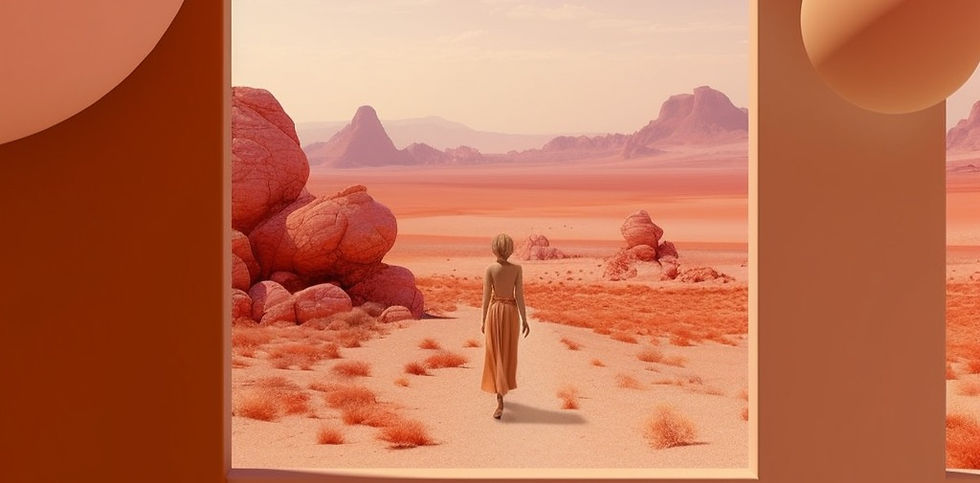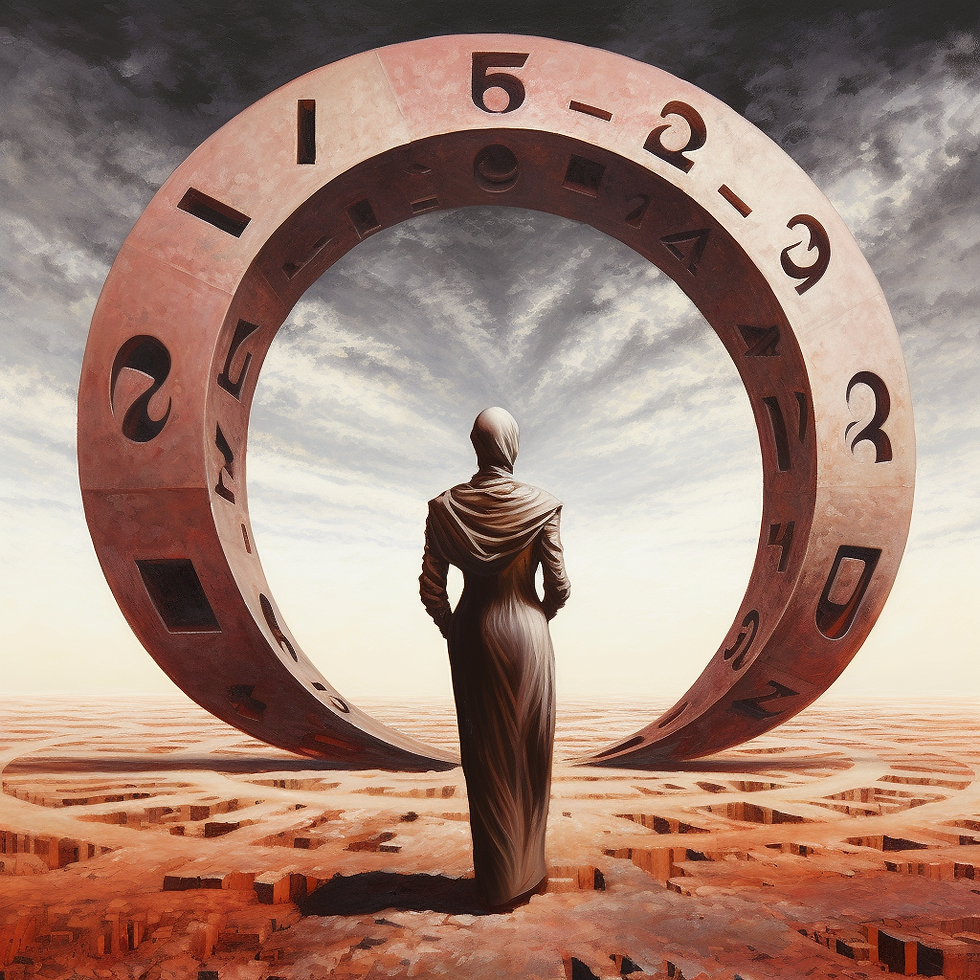Meet the Surreal Numbers: A Whole New World Beyond Real
- Surrealist

- May 7, 2023
- 5 min read
Updated: May 8, 2023


Imagine a world of numbers that goes beyond what we've known – a world where numbers can be infinitely large, infinitesimally small, and even something entirely different from what we've ever encountered.
But wait! Don't we have notations in calculus that allow us to describe concepts like infinity and infinitesimal, using tools like limits? Well, not quite. Calculus and algebra only identify the unbounded and uncountable nature of infinity. Calculus mostly asks questions like, "given no bounds to the expansion of the input, can we reason about the value that the expression tends to?". Hence, we don't have a concrete definition of "infinity" like we do, say "5" or "6". Infinity alludes us in this aspect.
You may ask, why should we care? Distinguishing between numbers like infinity and infinity + 1 or other kinds of infinities might not seem as useful in practical terms; we do just fine with tools like calculus and algebra. But there are curiosities in algebra that seem to differentiate certain infinities from others, and without a simple and lucid reason. See the Numberphile video about the series
(-1/12) = 1 + 2 + 3 + 4 + ... Maybe a new perspective on counting might reveal the deeper mysteries of math and unlock the secrets of this world. And in this spirit, welcome to the universe of surreal numbers! Discovered by John Horton Conway, a legendary mathematician, and popularized by Donald Knuth in his book "Surreal Numbers," this fascinating concept will take us on an extraordinary journey. We will start from the very basics and explore this intriguing world together.

Counting is a fundamental aspect of human existence. We rely on it to make sense of the world around us, to measure and quantify our experiences, and to communicate and share information. From the time we learn to count our fingers to solving complex equations, counting, and the symbols used for counting (numbers), are an integral part of our lives. Counting enables us a systematic way of organizing and understanding the universe.
Counting not only helps us navigate our daily lives, but it also serves as the foundation for mathematics and the various numerical systems that have been developed throughout history. The counting system we're most familiar with, called real numbers, is composed of integers, fractions, and decimals, among other numerical representations. These real numbers are used in unending ways to describe quantities, distances, and relationships between objects and ideas. But the real numbers are just the tip of the iceberg. There's a whole new world of numbers waiting to be explored, and it's called the realm of surreal numbers.
As we delve into the mysteries of counting and explore the importance of understanding why we count, we embark on a journey to uncover the hidden depths of numbers and their significance in our lives. From the most basic counting principles to the fascinating and complex world of surreal numbers, we'll discover that the realm of numbers is far more intricate and captivating than we could have ever imagined.

John Horton Conway, a mathematician known for his work in various fields like game theory and cellular automata, discovered surreal numbers in the 1970s. These numbers were so intriguing that they captured the attention of Donald Knuth, a renowned computer scientist and author. Knuth was so inspired that he wrote a book, "Surreal Numbers," which tells the fictional story of two characters who uncover the secrets of surreal numbers while stranded on a deserted island.
Constructing the World of Surreal Numbers
Day Zero: The Empty Set Φ
Φ or " "
0 = { Φ | Φ }The journey to surreal numbers begins with nothing Φ. That's right! Nothing, and a division.
Moving the nothing on either side, a simple concept, gives us a set with no elements on the left and no elements on the right. In the context of surreal numbers, the empty set represents the number zero.
The nothing that creates 0 seems so insignificant, but just like vacuum space, vibrating with virtual particles, this emptiness Φ will walk along with us, along with what we know and will be the starting point for constructing the entire world of surreal numbers.
0 can also be written as
0 = { | }
Day One: The First Generation of Surreal Numbers
0 = { | }
--
{ | 0 } = 1
{ 0 | } = -1Now that we have our starting point, let's create our first generation of surreal numbers. We'll define a surreal number as an ordered pair of sets, where each set contains surreal numbers. For now, our only surreal number is the empty set, which represents zero. By creating all possible ordered pairs with the empty set, we obtain two new surreal numbers:
{ 0 | }, { | 0 }These represent the numbers
-1, 1respectively.

Day Two: The Second Generation of Surreal Numbers
0 = { | }
1 = { | 0 }
-1 = { 0 | }
--
{ 1 | } = -2
{ -1| 0 } = -½
{ 0 | 1 } = ½
{ | 1 } = 2 As we continue our journey, we'll create the second generation of surreal numbers. We'll use the same method as before, creating all possible ordered pairs with the numbers we've obtained so far. This process yields four new surreal numbers:
{ 1 | }, { -1 | 0 }, { 0 | 1 }, { | 1 }. These new numbers represent
-2, -½, ½, and 2.This counting is identifying the simplest "gap" so far between the symbols we've found. The simplest gap in surreal terms so far, seems to be the "middle" of the numbers found so far.
So for day 2, -2 is the simplest number so far between nothing (Φ) and -1 -½ is the simplest number so far between -1 and 0 ½ is the simplest number so far between 0 and 1 2 is the simplest number so far between 1 and Φ
Moving the nothing (Φ) around all the knowledge we possess illuminates the "gaps" that we can fill-in. But wait! why are these not numbers?
{ 0 | 0 }, { 1 | 0 }, { 0 | -1 } Shouldn't we also assign symbols to these re-orderings?
Should we? Or maybe these numbers are not numbers, they are not "meaningful" as numbers in this counting system. What does that mean? Although unsatisfactory answers don't become satisfactory by being tentative, we could perhaps, for now, assume that these representations are not true "gaps", but indicate some uncertainty.

Continuing on,
Day Three: The Third Generation of Surreal Numbers Day Four: The Fourth Generation of Surreal Numbers Day Five: The Fifth Generation of Surreal Numbers
... Journey continues till the End of Countable Days
Journey Past Countable Days
...
The construction process can be repeated infinitely, with each new generation yielding new surreal numbers. As we venture deeper into this world, we'll encounter numbers that are infinitely large, infinitely small, and even numbers that can't be expressed as fractions or decimals. The realm of surreal numbers is vast and diverse, full of surprises and mind-bending concepts.

Our voyage into the world of surreal numbers has only just begun. There's so much more to explore and learn about these fascinating mathematical entities. As you continue your journey, don't be afraid to dive deeper, ask questions, and seek out new ways to understand and appreciate the beauty of surreal numbers.


It appears like the symbols used for counting are finding the "simplest gaps" - which seem to be the mid-points of each ordering. But what if we wanted to conceptually represent a "non-simple gap" in simpler terms? What would it mean to find a gap of a third or a fifth rather than the simplest mid point? Can we ask questions like - if this number system is only finding the midpoint, where in its counting could it encounter 1/3 or 1/5 or 1/7?

Comments